Royal Adelaide Hospital (RAH) Project: Comprehensive Report
VerifiedAdded on 2021/04/17
|16
|3541
|56
Report
AI Summary
This report provides a comprehensive analysis of the Royal Adelaide Hospital (RAH) project, a large medical facility construction undertaken in Southern Australia. The project, valued at over $1.85 billion, is currently in the execution and control phase. The report examines the project's environment, organizational aspects, leadership, and governance, highlighting the impact of government involvement. It identifies key risks, including financial risks, natural calamities, WHS risks, and data theft, proposing mitigation strategies for each. The report also explores the learnings from the project, such as the involvement of multiple stakeholders and the lack of risk management measures, and discusses their implications. Furthermore, it summarizes the findings related to resource allocation, communication among stakeholders, risk management, and employee training. The analysis emphasizes the need for effective project management, risk mitigation, and stakeholder collaboration to ensure the successful completion of the RAH project. The report also includes a reflective journal, providing a personal perspective on the project's challenges and successes.
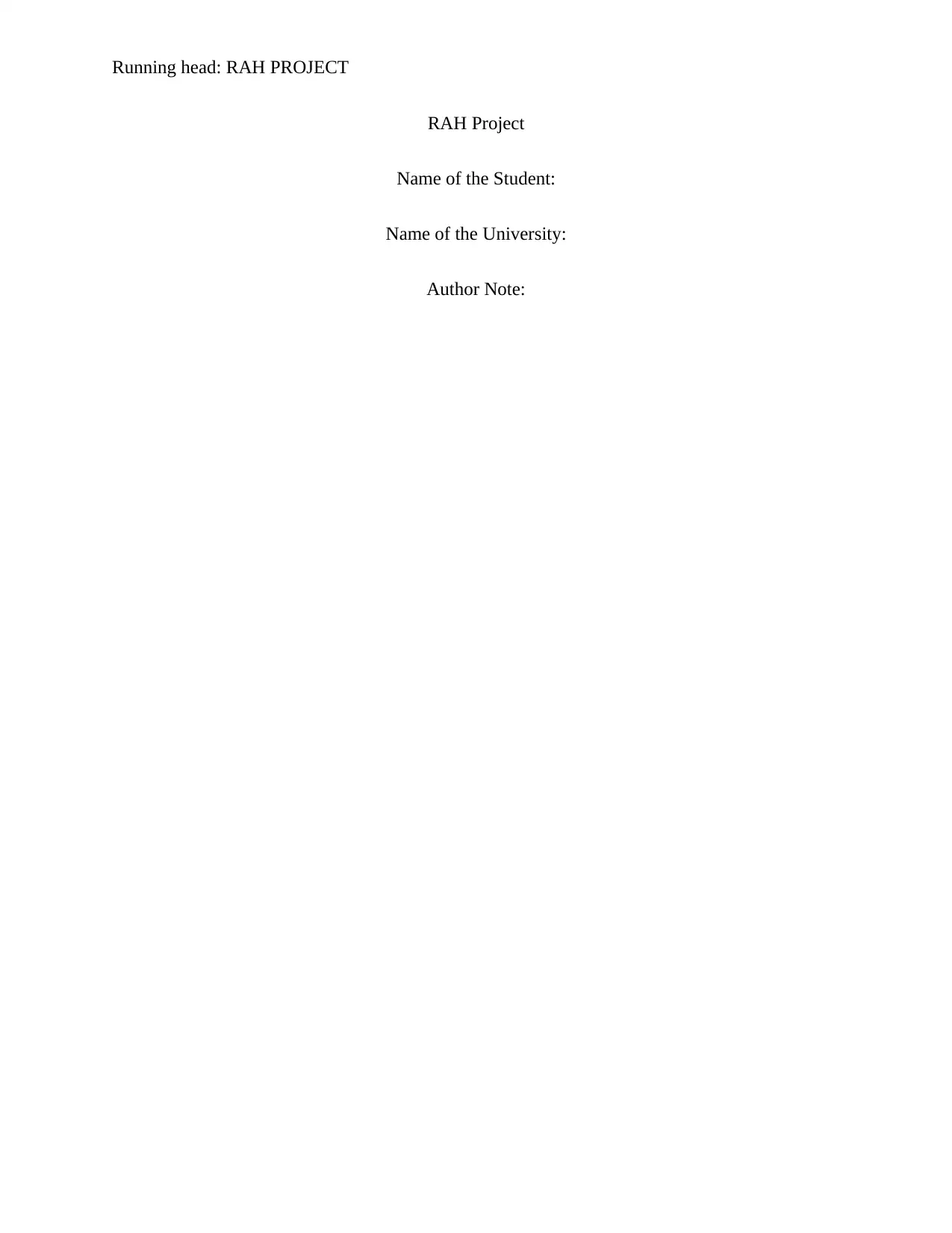
Running head: RAH PROJECT
RAH Project
Name of the Student:
Name of the University:
Author Note:
RAH Project
Name of the Student:
Name of the University:
Author Note:
Paraphrase This Document
Need a fresh take? Get an instant paraphrase of this document with our AI Paraphraser
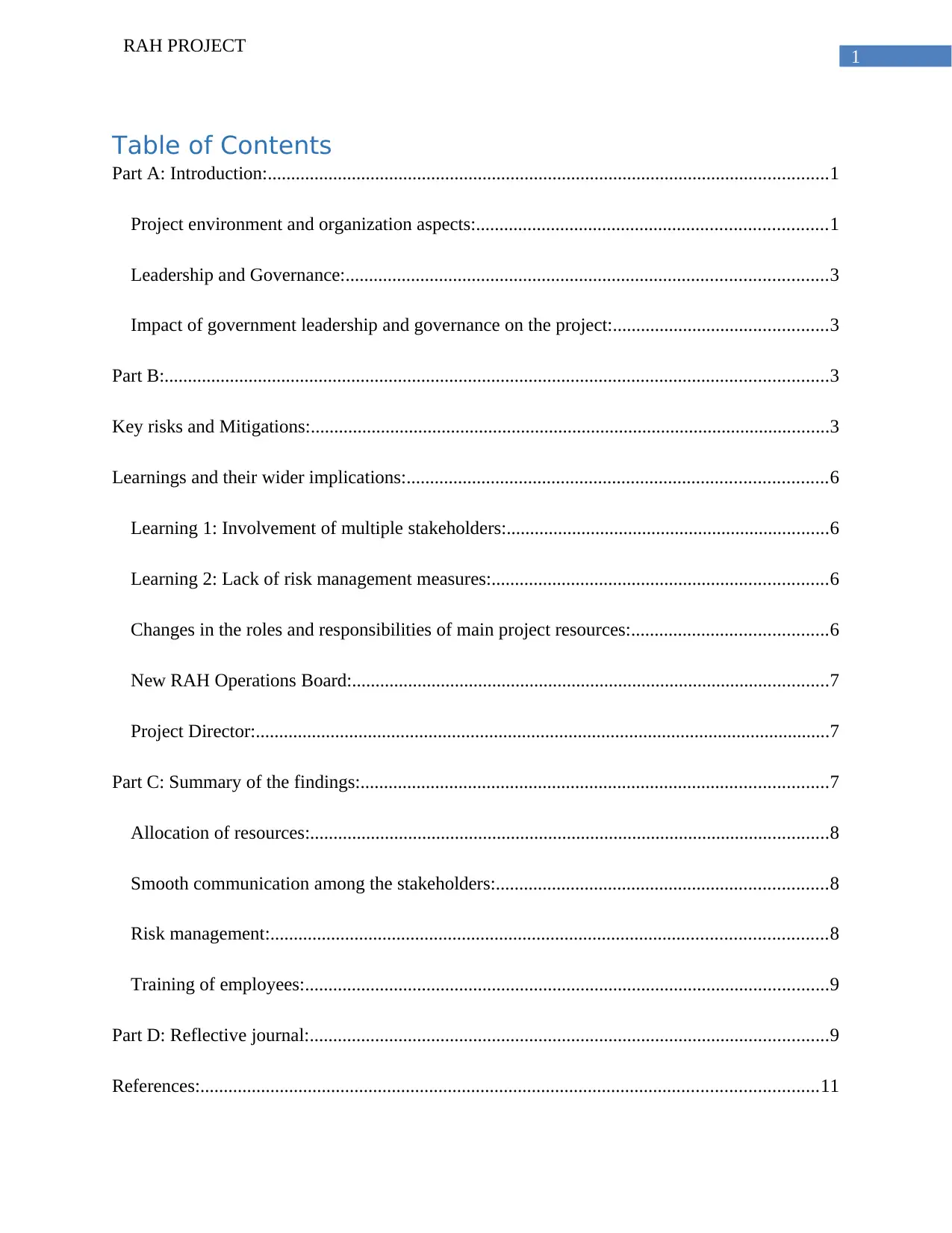
1
RAH PROJECT
Table of Contents
Part A: Introduction:........................................................................................................................1
Project environment and organization aspects:...........................................................................1
Leadership and Governance:.......................................................................................................3
Impact of government leadership and governance on the project:..............................................3
Part B:..............................................................................................................................................3
Key risks and Mitigations:...............................................................................................................3
Learnings and their wider implications:..........................................................................................6
Learning 1: Involvement of multiple stakeholders:.....................................................................6
Learning 2: Lack of risk management measures:........................................................................6
Changes in the roles and responsibilities of main project resources:..........................................6
New RAH Operations Board:......................................................................................................7
Project Director:...........................................................................................................................7
Part C: Summary of the findings:....................................................................................................7
Allocation of resources:...............................................................................................................8
Smooth communication among the stakeholders:.......................................................................8
Risk management:.......................................................................................................................8
Training of employees:................................................................................................................9
Part D: Reflective journal:...............................................................................................................9
References:....................................................................................................................................11
RAH PROJECT
Table of Contents
Part A: Introduction:........................................................................................................................1
Project environment and organization aspects:...........................................................................1
Leadership and Governance:.......................................................................................................3
Impact of government leadership and governance on the project:..............................................3
Part B:..............................................................................................................................................3
Key risks and Mitigations:...............................................................................................................3
Learnings and their wider implications:..........................................................................................6
Learning 1: Involvement of multiple stakeholders:.....................................................................6
Learning 2: Lack of risk management measures:........................................................................6
Changes in the roles and responsibilities of main project resources:..........................................6
New RAH Operations Board:......................................................................................................7
Project Director:...........................................................................................................................7
Part C: Summary of the findings:....................................................................................................7
Allocation of resources:...............................................................................................................8
Smooth communication among the stakeholders:.......................................................................8
Risk management:.......................................................................................................................8
Training of employees:................................................................................................................9
Part D: Reflective journal:...............................................................................................................9
References:....................................................................................................................................11
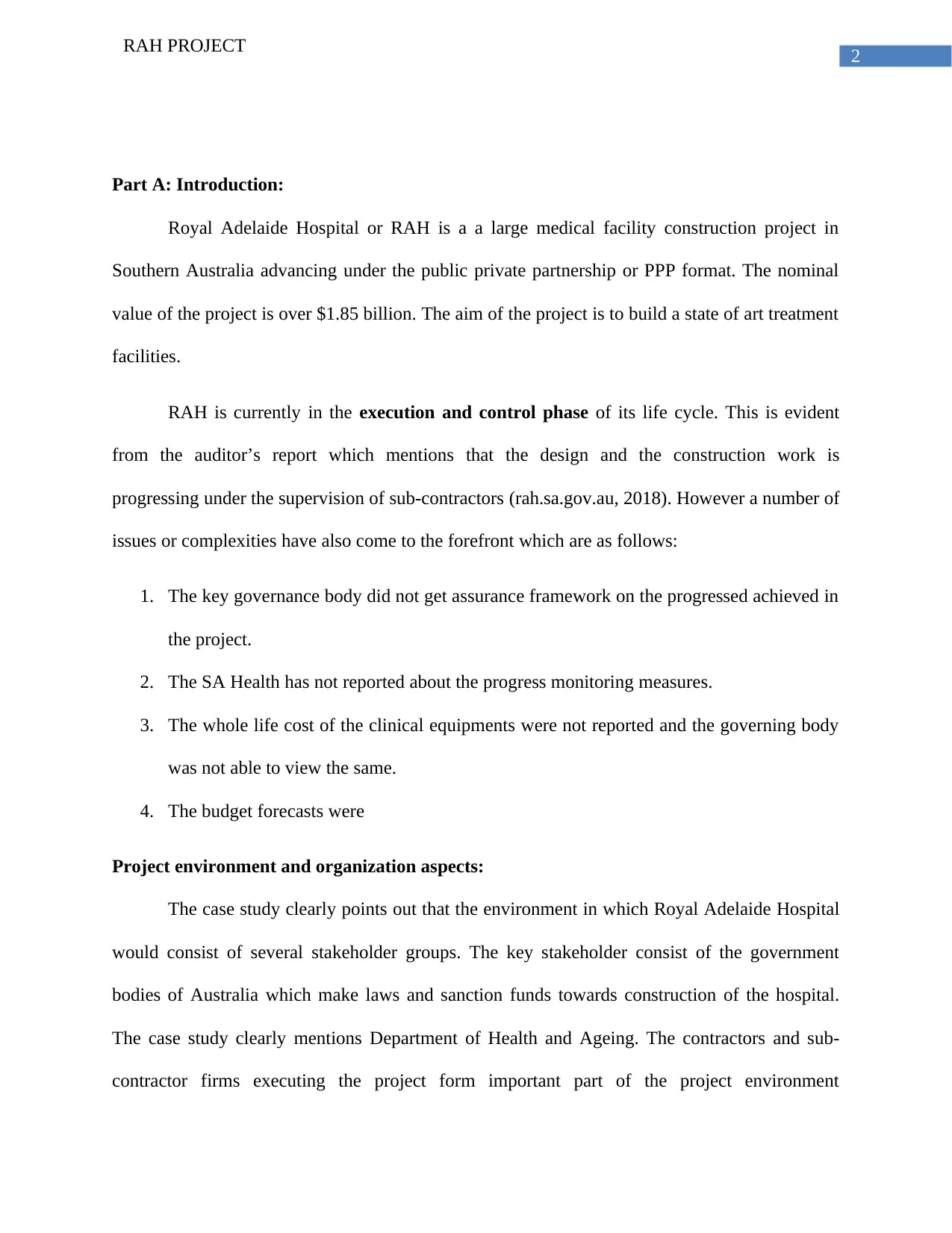
2
RAH PROJECT
Part A: Introduction:
Royal Adelaide Hospital or RAH is a a large medical facility construction project in
Southern Australia advancing under the public private partnership or PPP format. The nominal
value of the project is over $1.85 billion. The aim of the project is to build a state of art treatment
facilities.
RAH is currently in the execution and control phase of its life cycle. This is evident
from the auditor’s report which mentions that the design and the construction work is
progressing under the supervision of sub-contractors (rah.sa.gov.au, 2018). However a number of
issues or complexities have also come to the forefront which are as follows:
1. The key governance body did not get assurance framework on the progressed achieved in
the project.
2. The SA Health has not reported about the progress monitoring measures.
3. The whole life cost of the clinical equipments were not reported and the governing body
was not able to view the same.
4. The budget forecasts were
Project environment and organization aspects:
The case study clearly points out that the environment in which Royal Adelaide Hospital
would consist of several stakeholder groups. The key stakeholder consist of the government
bodies of Australia which make laws and sanction funds towards construction of the hospital.
The case study clearly mentions Department of Health and Ageing. The contractors and sub-
contractor firms executing the project form important part of the project environment
RAH PROJECT
Part A: Introduction:
Royal Adelaide Hospital or RAH is a a large medical facility construction project in
Southern Australia advancing under the public private partnership or PPP format. The nominal
value of the project is over $1.85 billion. The aim of the project is to build a state of art treatment
facilities.
RAH is currently in the execution and control phase of its life cycle. This is evident
from the auditor’s report which mentions that the design and the construction work is
progressing under the supervision of sub-contractors (rah.sa.gov.au, 2018). However a number of
issues or complexities have also come to the forefront which are as follows:
1. The key governance body did not get assurance framework on the progressed achieved in
the project.
2. The SA Health has not reported about the progress monitoring measures.
3. The whole life cost of the clinical equipments were not reported and the governing body
was not able to view the same.
4. The budget forecasts were
Project environment and organization aspects:
The case study clearly points out that the environment in which Royal Adelaide Hospital
would consist of several stakeholder groups. The key stakeholder consist of the government
bodies of Australia which make laws and sanction funds towards construction of the hospital.
The case study clearly mentions Department of Health and Ageing. The contractors and sub-
contractor firms executing the project form important part of the project environment
⊘ This is a preview!⊘
Do you want full access?
Subscribe today to unlock all pages.

Trusted by 1+ million students worldwide
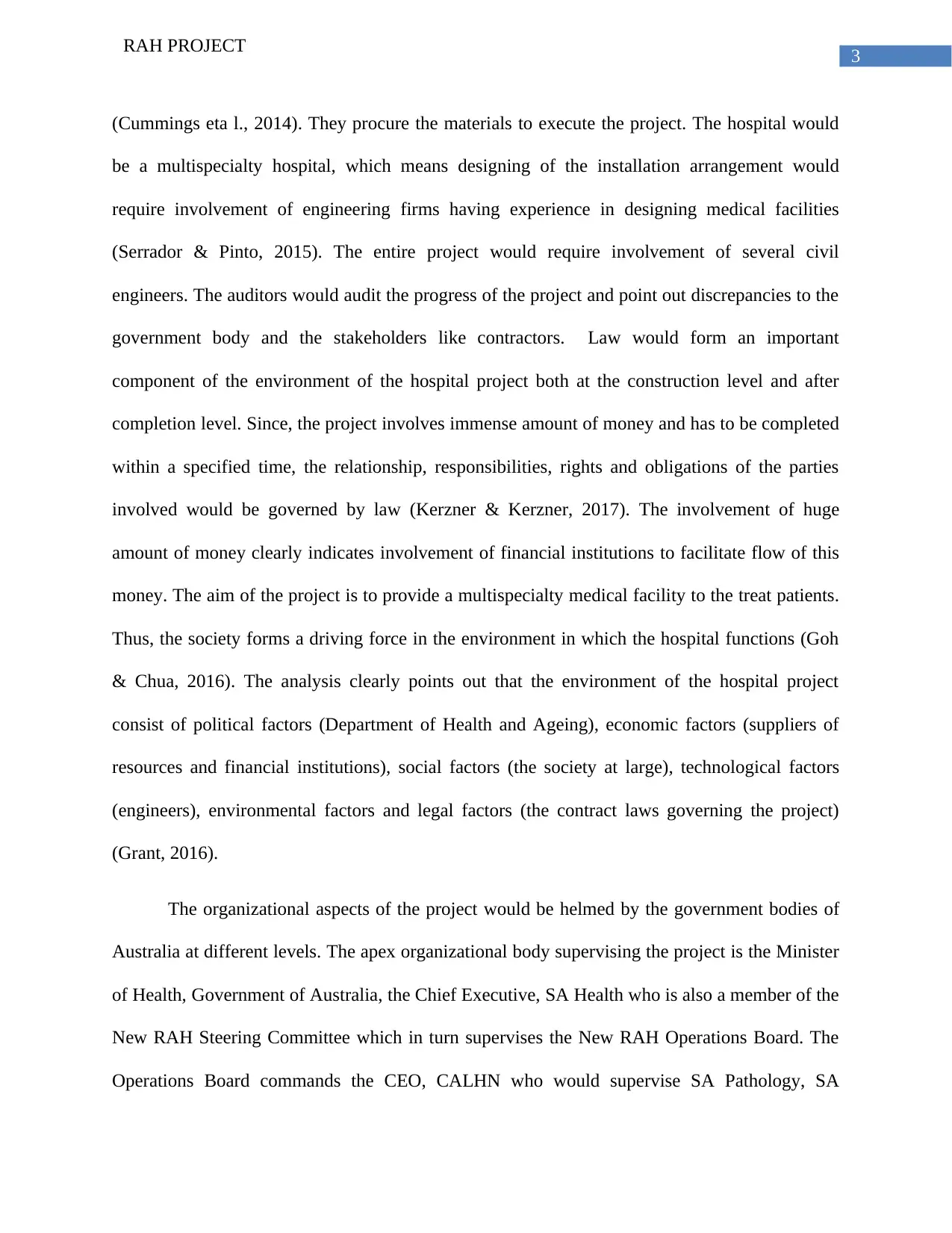
3
RAH PROJECT
(Cummings eta l., 2014). They procure the materials to execute the project. The hospital would
be a multispecialty hospital, which means designing of the installation arrangement would
require involvement of engineering firms having experience in designing medical facilities
(Serrador & Pinto, 2015). The entire project would require involvement of several civil
engineers. The auditors would audit the progress of the project and point out discrepancies to the
government body and the stakeholders like contractors. Law would form an important
component of the environment of the hospital project both at the construction level and after
completion level. Since, the project involves immense amount of money and has to be completed
within a specified time, the relationship, responsibilities, rights and obligations of the parties
involved would be governed by law (Kerzner & Kerzner, 2017). The involvement of huge
amount of money clearly indicates involvement of financial institutions to facilitate flow of this
money. The aim of the project is to provide a multispecialty medical facility to the treat patients.
Thus, the society forms a driving force in the environment in which the hospital functions (Goh
& Chua, 2016). The analysis clearly points out that the environment of the hospital project
consist of political factors (Department of Health and Ageing), economic factors (suppliers of
resources and financial institutions), social factors (the society at large), technological factors
(engineers), environmental factors and legal factors (the contract laws governing the project)
(Grant, 2016).
The organizational aspects of the project would be helmed by the government bodies of
Australia at different levels. The apex organizational body supervising the project is the Minister
of Health, Government of Australia, the Chief Executive, SA Health who is also a member of the
New RAH Steering Committee which in turn supervises the New RAH Operations Board. The
Operations Board commands the CEO, CALHN who would supervise SA Pathology, SA
RAH PROJECT
(Cummings eta l., 2014). They procure the materials to execute the project. The hospital would
be a multispecialty hospital, which means designing of the installation arrangement would
require involvement of engineering firms having experience in designing medical facilities
(Serrador & Pinto, 2015). The entire project would require involvement of several civil
engineers. The auditors would audit the progress of the project and point out discrepancies to the
government body and the stakeholders like contractors. Law would form an important
component of the environment of the hospital project both at the construction level and after
completion level. Since, the project involves immense amount of money and has to be completed
within a specified time, the relationship, responsibilities, rights and obligations of the parties
involved would be governed by law (Kerzner & Kerzner, 2017). The involvement of huge
amount of money clearly indicates involvement of financial institutions to facilitate flow of this
money. The aim of the project is to provide a multispecialty medical facility to the treat patients.
Thus, the society forms a driving force in the environment in which the hospital functions (Goh
& Chua, 2016). The analysis clearly points out that the environment of the hospital project
consist of political factors (Department of Health and Ageing), economic factors (suppliers of
resources and financial institutions), social factors (the society at large), technological factors
(engineers), environmental factors and legal factors (the contract laws governing the project)
(Grant, 2016).
The organizational aspects of the project would be helmed by the government bodies of
Australia at different levels. The apex organizational body supervising the project is the Minister
of Health, Government of Australia, the Chief Executive, SA Health who is also a member of the
New RAH Steering Committee which in turn supervises the New RAH Operations Board. The
Operations Board commands the CEO, CALHN who would supervise SA Pathology, SA
Paraphrase This Document
Need a fresh take? Get an instant paraphrase of this document with our AI Paraphraser
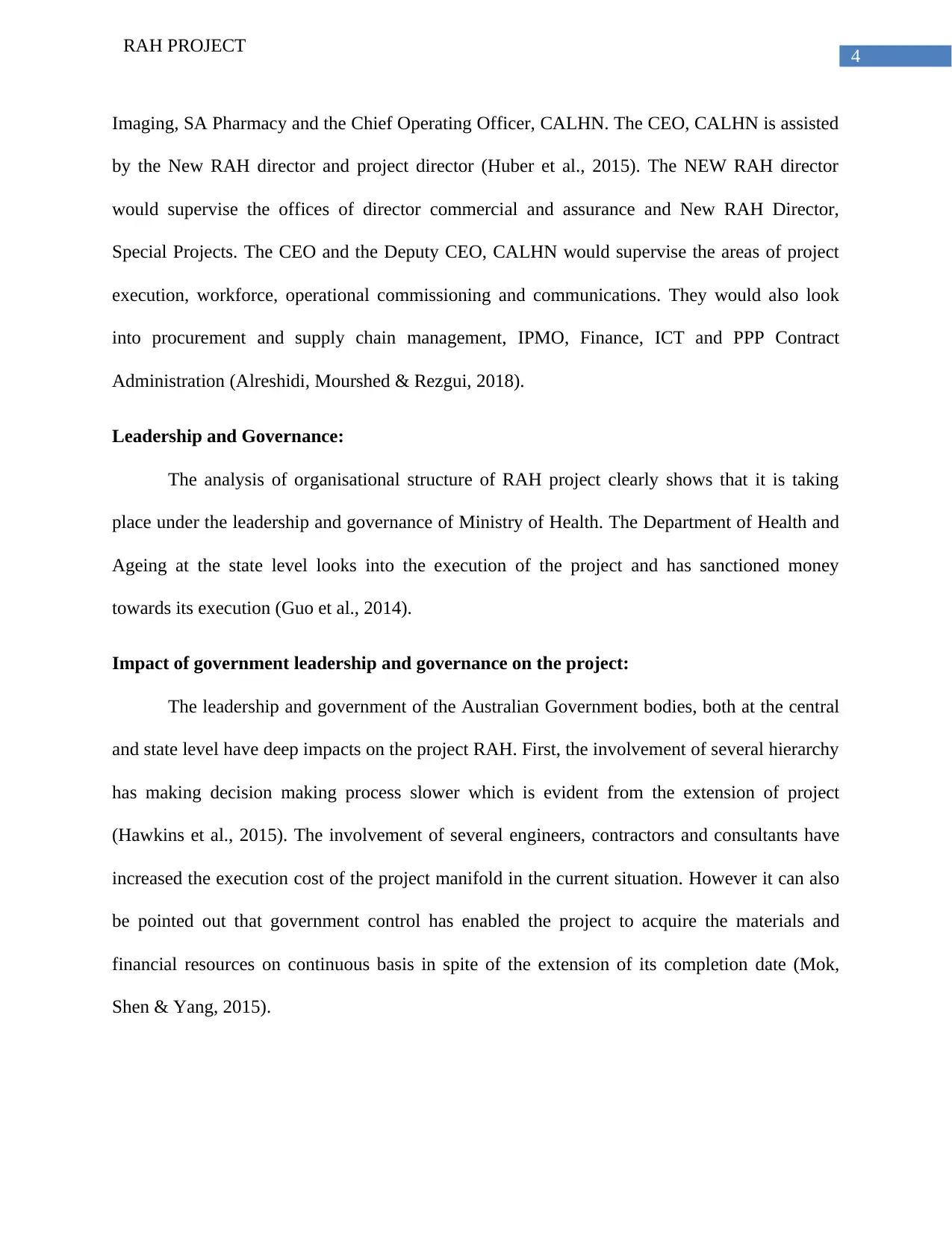
4
RAH PROJECT
Imaging, SA Pharmacy and the Chief Operating Officer, CALHN. The CEO, CALHN is assisted
by the New RAH director and project director (Huber et al., 2015). The NEW RAH director
would supervise the offices of director commercial and assurance and New RAH Director,
Special Projects. The CEO and the Deputy CEO, CALHN would supervise the areas of project
execution, workforce, operational commissioning and communications. They would also look
into procurement and supply chain management, IPMO, Finance, ICT and PPP Contract
Administration (Alreshidi, Mourshed & Rezgui, 2018).
Leadership and Governance:
The analysis of organisational structure of RAH project clearly shows that it is taking
place under the leadership and governance of Ministry of Health. The Department of Health and
Ageing at the state level looks into the execution of the project and has sanctioned money
towards its execution (Guo et al., 2014).
Impact of government leadership and governance on the project:
The leadership and government of the Australian Government bodies, both at the central
and state level have deep impacts on the project RAH. First, the involvement of several hierarchy
has making decision making process slower which is evident from the extension of project
(Hawkins et al., 2015). The involvement of several engineers, contractors and consultants have
increased the execution cost of the project manifold in the current situation. However it can also
be pointed out that government control has enabled the project to acquire the materials and
financial resources on continuous basis in spite of the extension of its completion date (Mok,
Shen & Yang, 2015).
RAH PROJECT
Imaging, SA Pharmacy and the Chief Operating Officer, CALHN. The CEO, CALHN is assisted
by the New RAH director and project director (Huber et al., 2015). The NEW RAH director
would supervise the offices of director commercial and assurance and New RAH Director,
Special Projects. The CEO and the Deputy CEO, CALHN would supervise the areas of project
execution, workforce, operational commissioning and communications. They would also look
into procurement and supply chain management, IPMO, Finance, ICT and PPP Contract
Administration (Alreshidi, Mourshed & Rezgui, 2018).
Leadership and Governance:
The analysis of organisational structure of RAH project clearly shows that it is taking
place under the leadership and governance of Ministry of Health. The Department of Health and
Ageing at the state level looks into the execution of the project and has sanctioned money
towards its execution (Guo et al., 2014).
Impact of government leadership and governance on the project:
The leadership and government of the Australian Government bodies, both at the central
and state level have deep impacts on the project RAH. First, the involvement of several hierarchy
has making decision making process slower which is evident from the extension of project
(Hawkins et al., 2015). The involvement of several engineers, contractors and consultants have
increased the execution cost of the project manifold in the current situation. However it can also
be pointed out that government control has enabled the project to acquire the materials and
financial resources on continuous basis in spite of the extension of its completion date (Mok,
Shen & Yang, 2015).
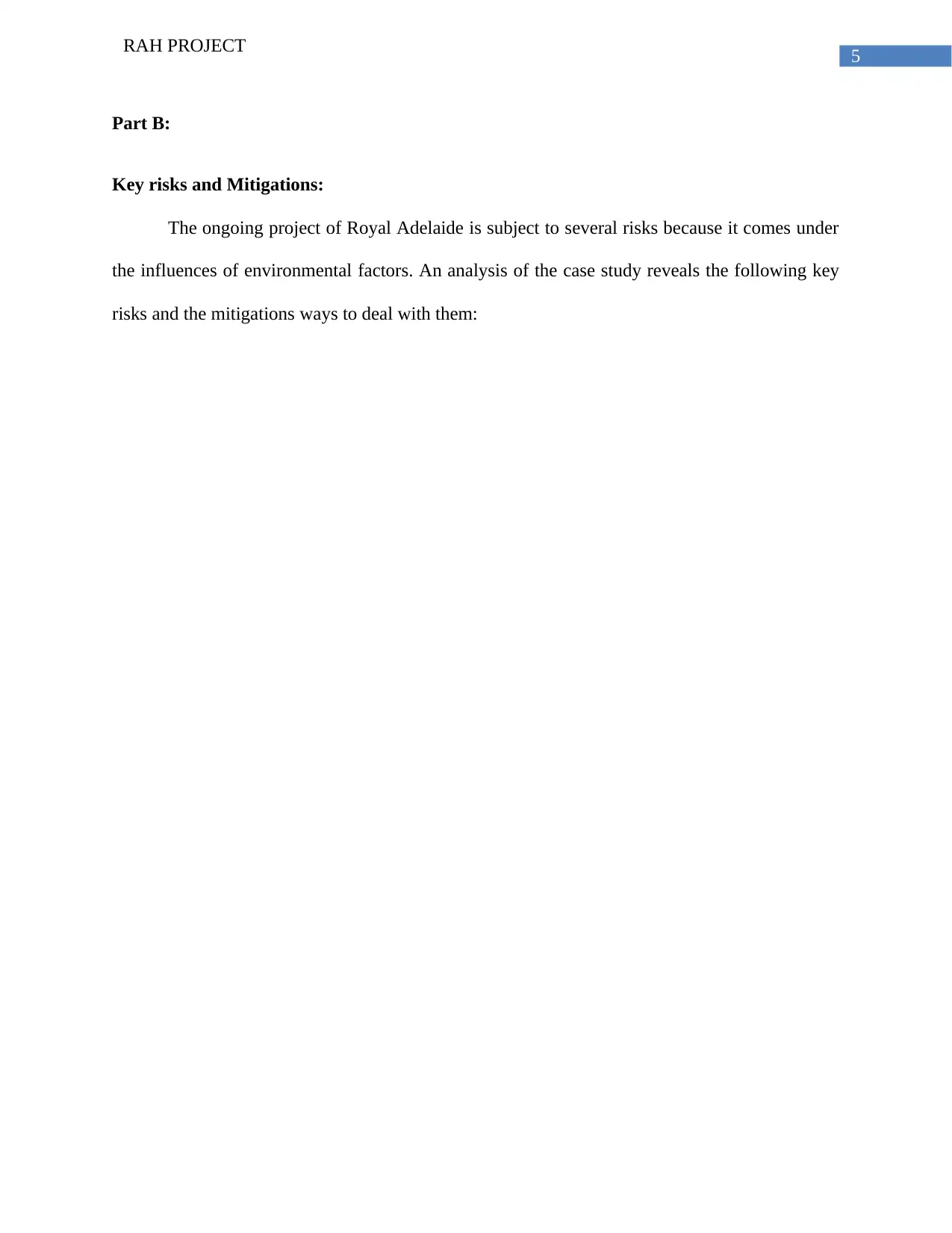
5
RAH PROJECT
Part B:
Key risks and Mitigations:
The ongoing project of Royal Adelaide is subject to several risks because it comes under
the influences of environmental factors. An analysis of the case study reveals the following key
risks and the mitigations ways to deal with them:
RAH PROJECT
Part B:
Key risks and Mitigations:
The ongoing project of Royal Adelaide is subject to several risks because it comes under
the influences of environmental factors. An analysis of the case study reveals the following key
risks and the mitigations ways to deal with them:
⊘ This is a preview!⊘
Do you want full access?
Subscribe today to unlock all pages.

Trusted by 1+ million students worldwide
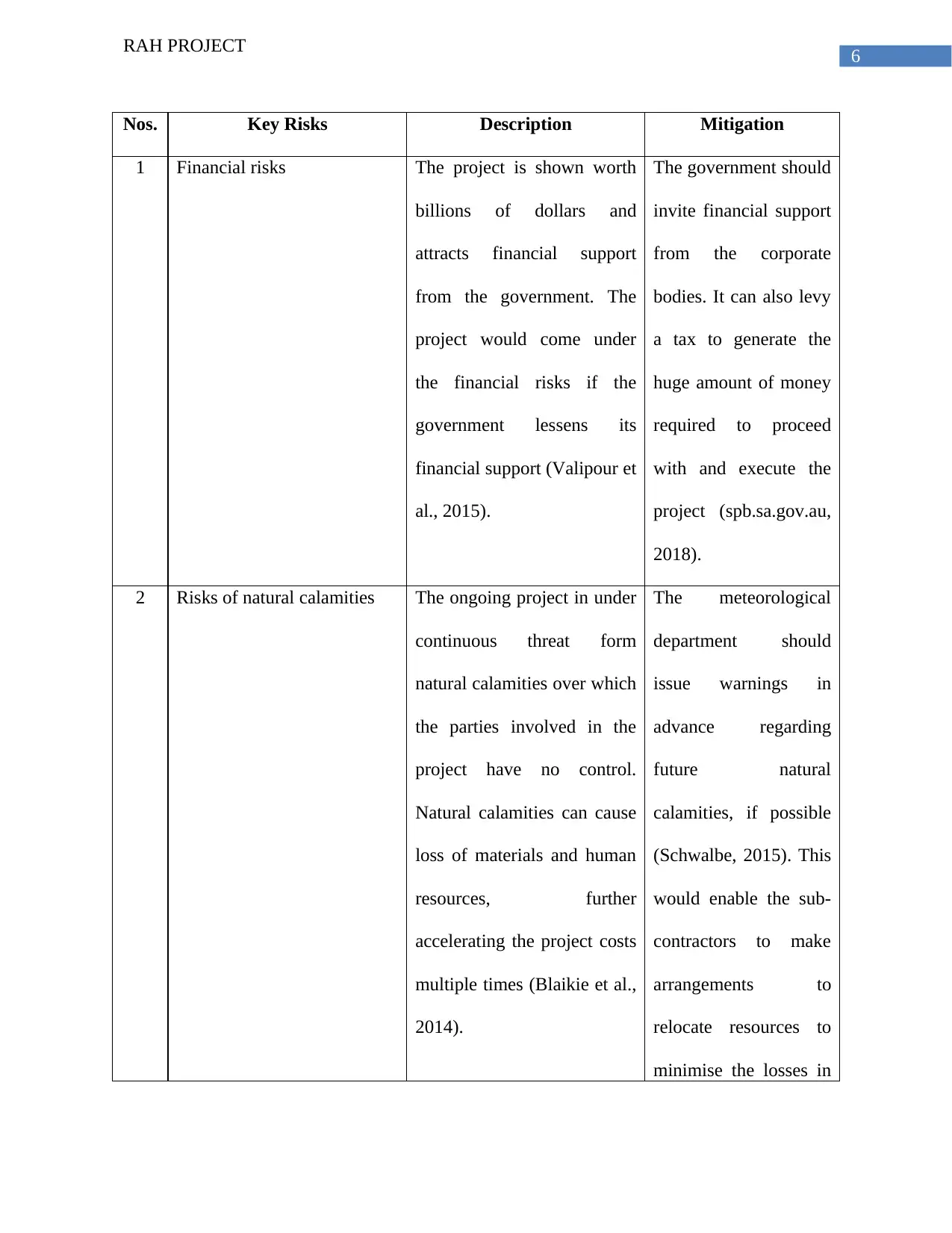
6
RAH PROJECT
Nos. Key Risks Description Mitigation
1 Financial risks The project is shown worth
billions of dollars and
attracts financial support
from the government. The
project would come under
the financial risks if the
government lessens its
financial support (Valipour et
al., 2015).
The government should
invite financial support
from the corporate
bodies. It can also levy
a tax to generate the
huge amount of money
required to proceed
with and execute the
project (spb.sa.gov.au,
2018).
2 Risks of natural calamities The ongoing project in under
continuous threat form
natural calamities over which
the parties involved in the
project have no control.
Natural calamities can cause
loss of materials and human
resources, further
accelerating the project costs
multiple times (Blaikie et al.,
2014).
The meteorological
department should
issue warnings in
advance regarding
future natural
calamities, if possible
(Schwalbe, 2015). This
would enable the sub-
contractors to make
arrangements to
relocate resources to
minimise the losses in
RAH PROJECT
Nos. Key Risks Description Mitigation
1 Financial risks The project is shown worth
billions of dollars and
attracts financial support
from the government. The
project would come under
the financial risks if the
government lessens its
financial support (Valipour et
al., 2015).
The government should
invite financial support
from the corporate
bodies. It can also levy
a tax to generate the
huge amount of money
required to proceed
with and execute the
project (spb.sa.gov.au,
2018).
2 Risks of natural calamities The ongoing project in under
continuous threat form
natural calamities over which
the parties involved in the
project have no control.
Natural calamities can cause
loss of materials and human
resources, further
accelerating the project costs
multiple times (Blaikie et al.,
2014).
The meteorological
department should
issue warnings in
advance regarding
future natural
calamities, if possible
(Schwalbe, 2015). This
would enable the sub-
contractors to make
arrangements to
relocate resources to
minimise the losses in
Paraphrase This Document
Need a fresh take? Get an instant paraphrase of this document with our AI Paraphraser
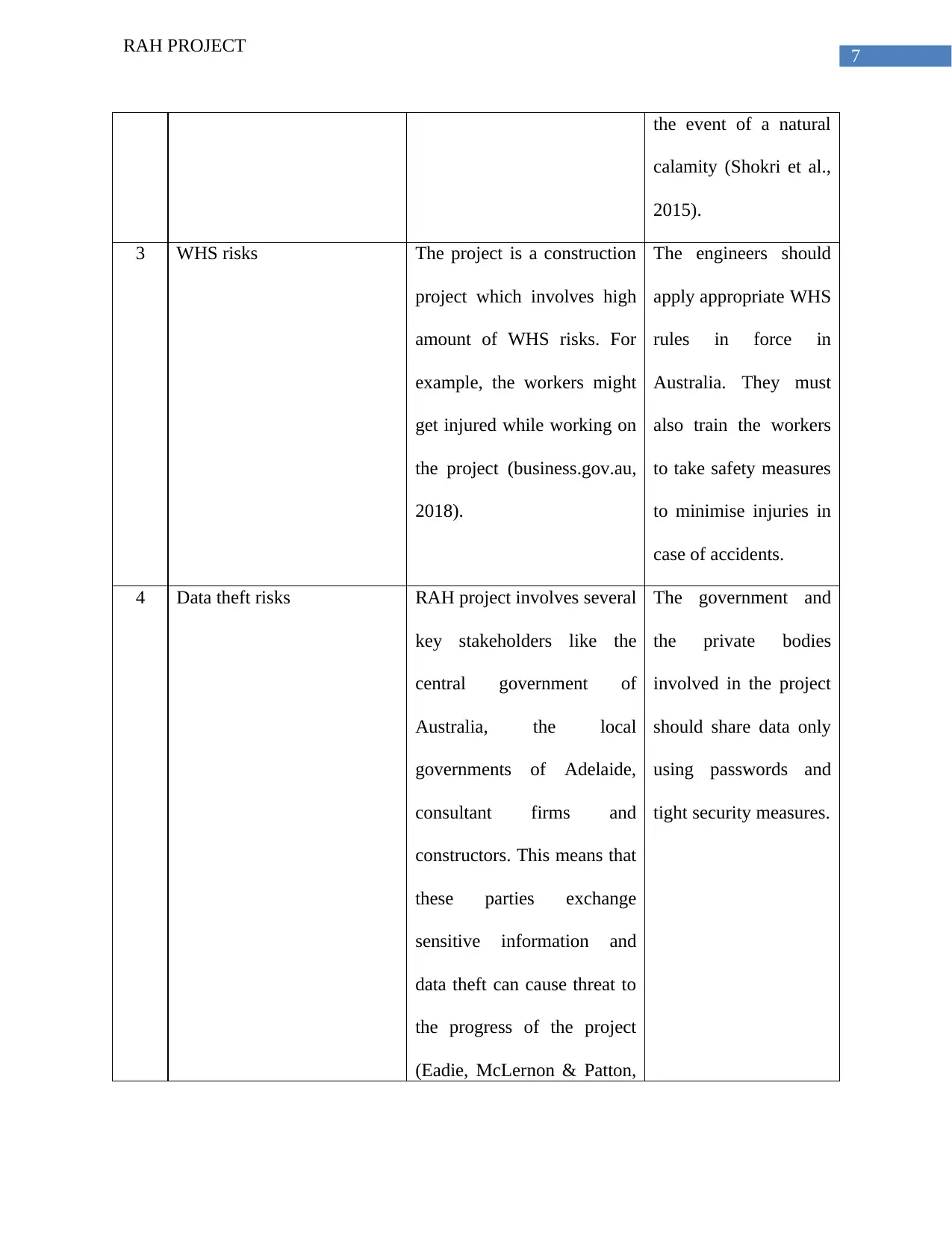
7
RAH PROJECT
the event of a natural
calamity (Shokri et al.,
2015).
3 WHS risks The project is a construction
project which involves high
amount of WHS risks. For
example, the workers might
get injured while working on
the project (business.gov.au,
2018).
The engineers should
apply appropriate WHS
rules in force in
Australia. They must
also train the workers
to take safety measures
to minimise injuries in
case of accidents.
4 Data theft risks RAH project involves several
key stakeholders like the
central government of
Australia, the local
governments of Adelaide,
consultant firms and
constructors. This means that
these parties exchange
sensitive information and
data theft can cause threat to
the progress of the project
(Eadie, McLernon & Patton,
The government and
the private bodies
involved in the project
should share data only
using passwords and
tight security measures.
RAH PROJECT
the event of a natural
calamity (Shokri et al.,
2015).
3 WHS risks The project is a construction
project which involves high
amount of WHS risks. For
example, the workers might
get injured while working on
the project (business.gov.au,
2018).
The engineers should
apply appropriate WHS
rules in force in
Australia. They must
also train the workers
to take safety measures
to minimise injuries in
case of accidents.
4 Data theft risks RAH project involves several
key stakeholders like the
central government of
Australia, the local
governments of Adelaide,
consultant firms and
constructors. This means that
these parties exchange
sensitive information and
data theft can cause threat to
the progress of the project
(Eadie, McLernon & Patton,
The government and
the private bodies
involved in the project
should share data only
using passwords and
tight security measures.
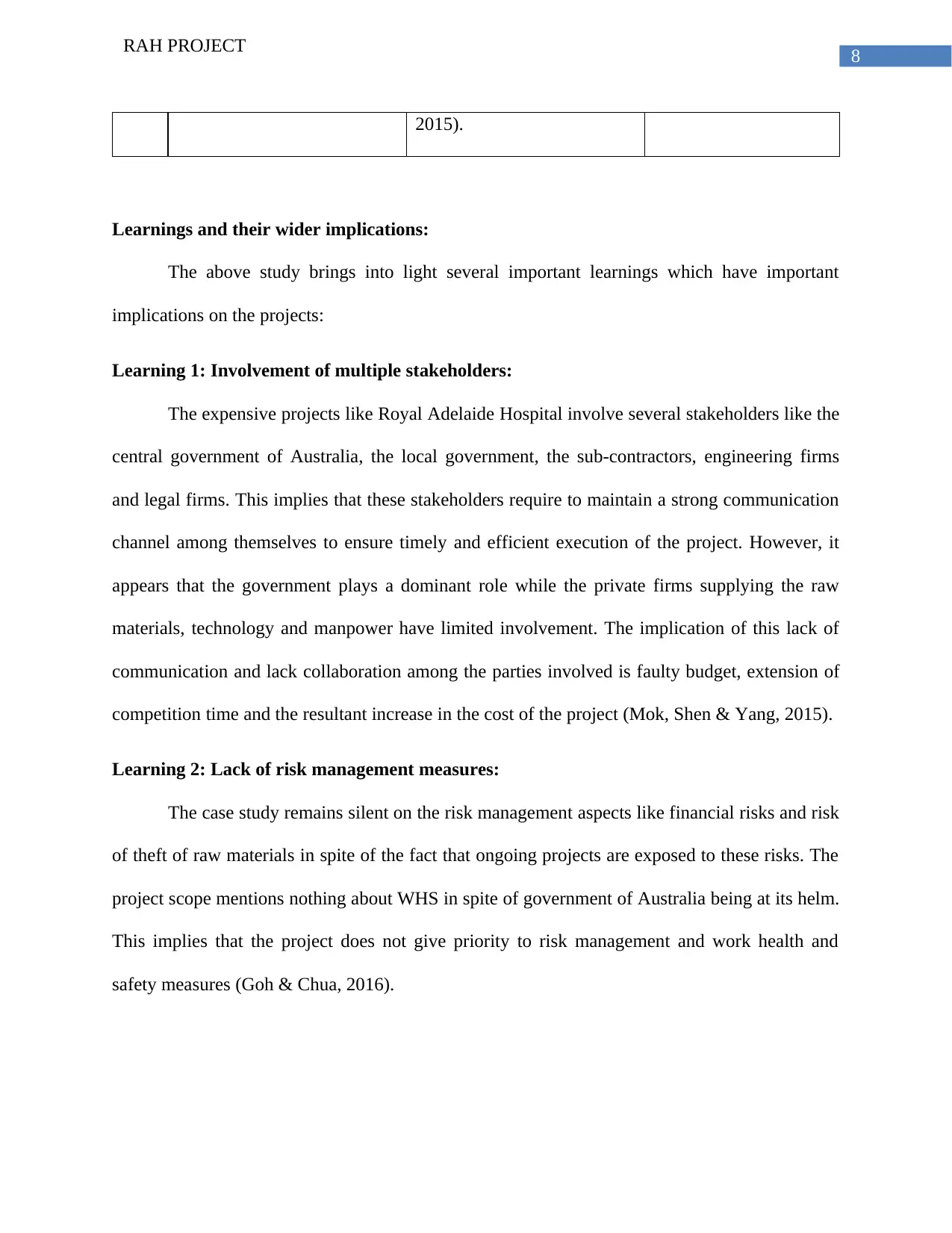
8
RAH PROJECT
2015).
Learnings and their wider implications:
The above study brings into light several important learnings which have important
implications on the projects:
Learning 1: Involvement of multiple stakeholders:
The expensive projects like Royal Adelaide Hospital involve several stakeholders like the
central government of Australia, the local government, the sub-contractors, engineering firms
and legal firms. This implies that these stakeholders require to maintain a strong communication
channel among themselves to ensure timely and efficient execution of the project. However, it
appears that the government plays a dominant role while the private firms supplying the raw
materials, technology and manpower have limited involvement. The implication of this lack of
communication and lack collaboration among the parties involved is faulty budget, extension of
competition time and the resultant increase in the cost of the project (Mok, Shen & Yang, 2015).
Learning 2: Lack of risk management measures:
The case study remains silent on the risk management aspects like financial risks and risk
of theft of raw materials in spite of the fact that ongoing projects are exposed to these risks. The
project scope mentions nothing about WHS in spite of government of Australia being at its helm.
This implies that the project does not give priority to risk management and work health and
safety measures (Goh & Chua, 2016).
RAH PROJECT
2015).
Learnings and their wider implications:
The above study brings into light several important learnings which have important
implications on the projects:
Learning 1: Involvement of multiple stakeholders:
The expensive projects like Royal Adelaide Hospital involve several stakeholders like the
central government of Australia, the local government, the sub-contractors, engineering firms
and legal firms. This implies that these stakeholders require to maintain a strong communication
channel among themselves to ensure timely and efficient execution of the project. However, it
appears that the government plays a dominant role while the private firms supplying the raw
materials, technology and manpower have limited involvement. The implication of this lack of
communication and lack collaboration among the parties involved is faulty budget, extension of
competition time and the resultant increase in the cost of the project (Mok, Shen & Yang, 2015).
Learning 2: Lack of risk management measures:
The case study remains silent on the risk management aspects like financial risks and risk
of theft of raw materials in spite of the fact that ongoing projects are exposed to these risks. The
project scope mentions nothing about WHS in spite of government of Australia being at its helm.
This implies that the project does not give priority to risk management and work health and
safety measures (Goh & Chua, 2016).
⊘ This is a preview!⊘
Do you want full access?
Subscribe today to unlock all pages.

Trusted by 1+ million students worldwide
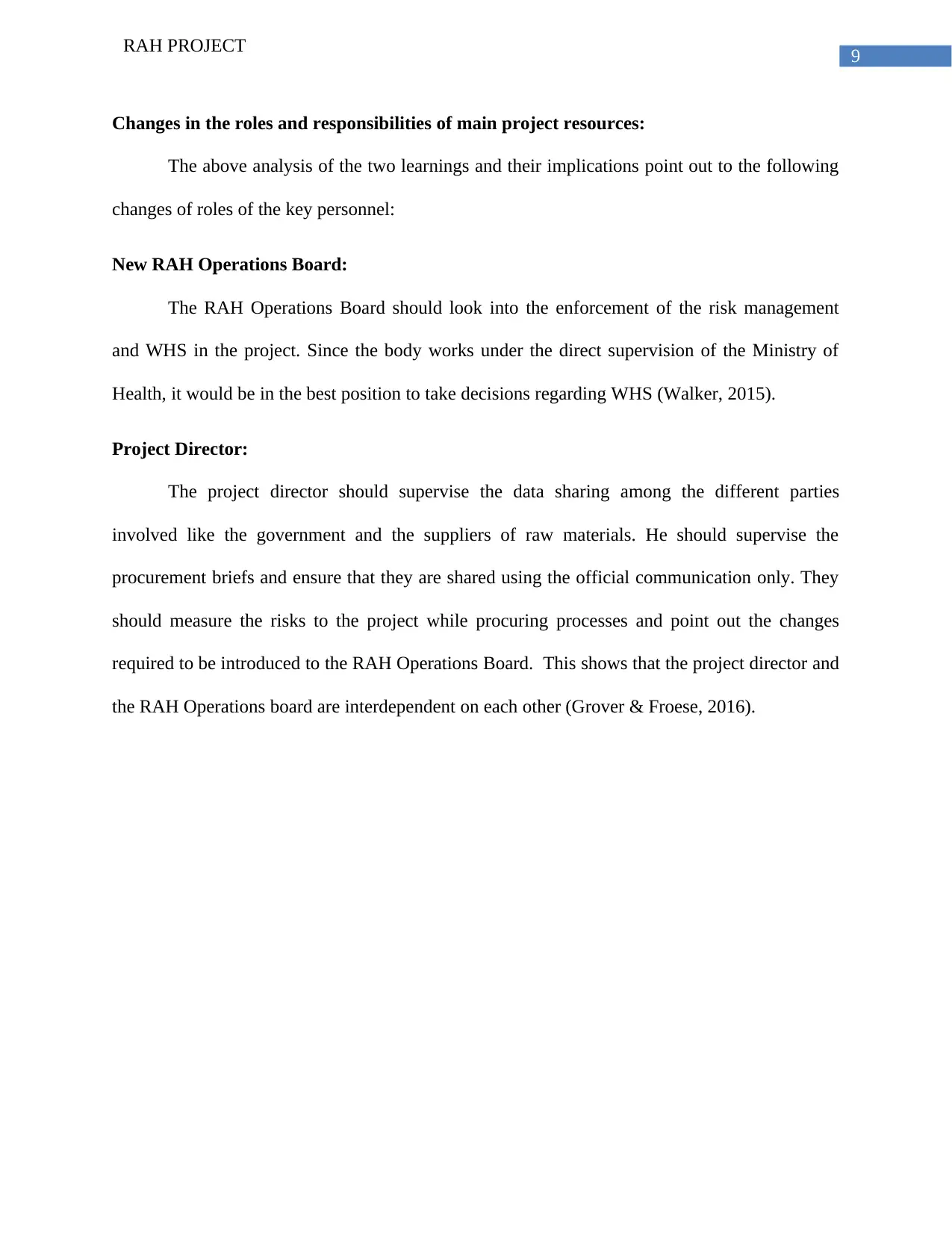
9
RAH PROJECT
Changes in the roles and responsibilities of main project resources:
The above analysis of the two learnings and their implications point out to the following
changes of roles of the key personnel:
New RAH Operations Board:
The RAH Operations Board should look into the enforcement of the risk management
and WHS in the project. Since the body works under the direct supervision of the Ministry of
Health, it would be in the best position to take decisions regarding WHS (Walker, 2015).
Project Director:
The project director should supervise the data sharing among the different parties
involved like the government and the suppliers of raw materials. He should supervise the
procurement briefs and ensure that they are shared using the official communication only. They
should measure the risks to the project while procuring processes and point out the changes
required to be introduced to the RAH Operations Board. This shows that the project director and
the RAH Operations board are interdependent on each other (Grover & Froese, 2016).
RAH PROJECT
Changes in the roles and responsibilities of main project resources:
The above analysis of the two learnings and their implications point out to the following
changes of roles of the key personnel:
New RAH Operations Board:
The RAH Operations Board should look into the enforcement of the risk management
and WHS in the project. Since the body works under the direct supervision of the Ministry of
Health, it would be in the best position to take decisions regarding WHS (Walker, 2015).
Project Director:
The project director should supervise the data sharing among the different parties
involved like the government and the suppliers of raw materials. He should supervise the
procurement briefs and ensure that they are shared using the official communication only. They
should measure the risks to the project while procuring processes and point out the changes
required to be introduced to the RAH Operations Board. This shows that the project director and
the RAH Operations board are interdependent on each other (Grover & Froese, 2016).
Paraphrase This Document
Need a fresh take? Get an instant paraphrase of this document with our AI Paraphraser
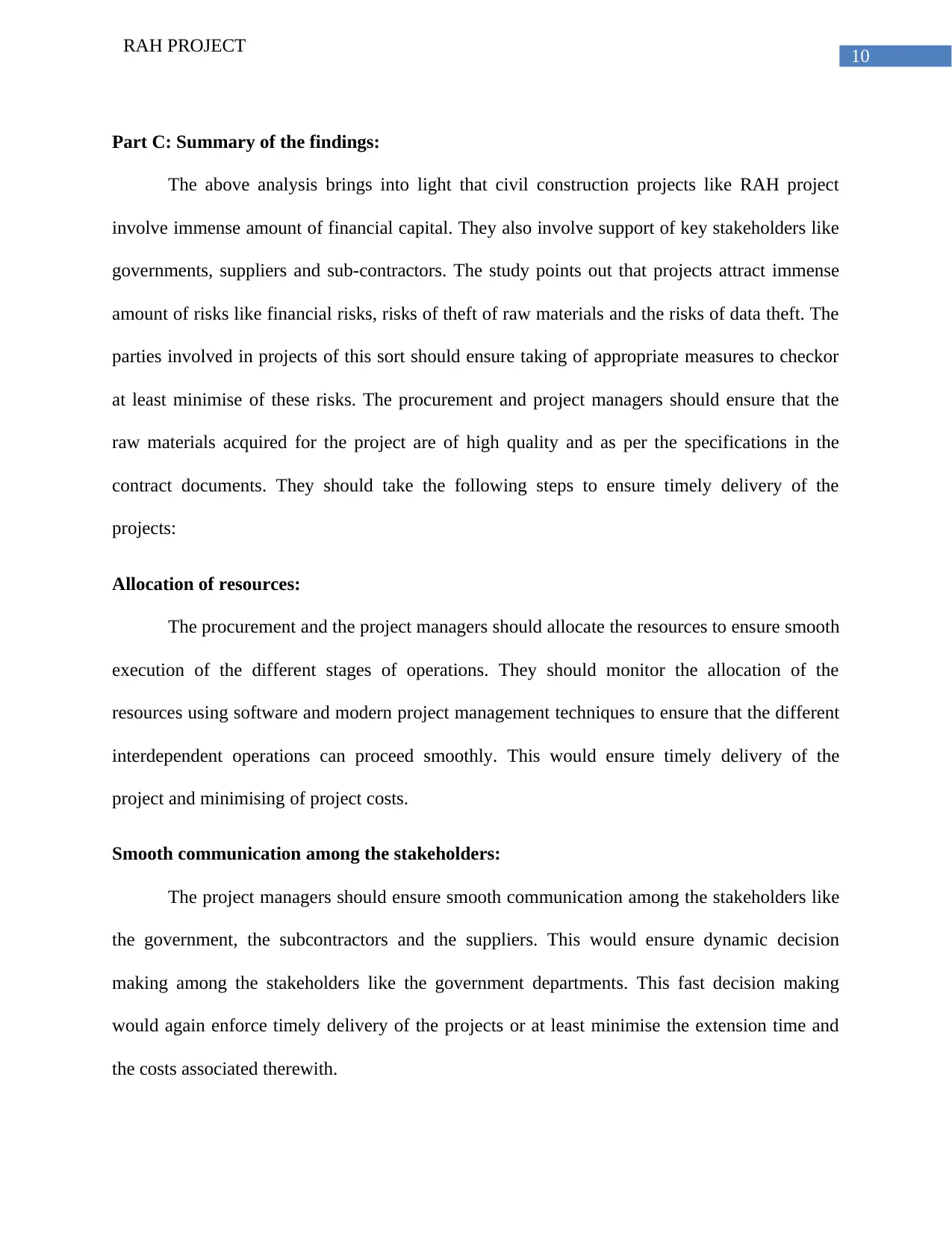
10
RAH PROJECT
Part C: Summary of the findings:
The above analysis brings into light that civil construction projects like RAH project
involve immense amount of financial capital. They also involve support of key stakeholders like
governments, suppliers and sub-contractors. The study points out that projects attract immense
amount of risks like financial risks, risks of theft of raw materials and the risks of data theft. The
parties involved in projects of this sort should ensure taking of appropriate measures to checkor
at least minimise of these risks. The procurement and project managers should ensure that the
raw materials acquired for the project are of high quality and as per the specifications in the
contract documents. They should take the following steps to ensure timely delivery of the
projects:
Allocation of resources:
The procurement and the project managers should allocate the resources to ensure smooth
execution of the different stages of operations. They should monitor the allocation of the
resources using software and modern project management techniques to ensure that the different
interdependent operations can proceed smoothly. This would ensure timely delivery of the
project and minimising of project costs.
Smooth communication among the stakeholders:
The project managers should ensure smooth communication among the stakeholders like
the government, the subcontractors and the suppliers. This would ensure dynamic decision
making among the stakeholders like the government departments. This fast decision making
would again enforce timely delivery of the projects or at least minimise the extension time and
the costs associated therewith.
RAH PROJECT
Part C: Summary of the findings:
The above analysis brings into light that civil construction projects like RAH project
involve immense amount of financial capital. They also involve support of key stakeholders like
governments, suppliers and sub-contractors. The study points out that projects attract immense
amount of risks like financial risks, risks of theft of raw materials and the risks of data theft. The
parties involved in projects of this sort should ensure taking of appropriate measures to checkor
at least minimise of these risks. The procurement and project managers should ensure that the
raw materials acquired for the project are of high quality and as per the specifications in the
contract documents. They should take the following steps to ensure timely delivery of the
projects:
Allocation of resources:
The procurement and the project managers should allocate the resources to ensure smooth
execution of the different stages of operations. They should monitor the allocation of the
resources using software and modern project management techniques to ensure that the different
interdependent operations can proceed smoothly. This would ensure timely delivery of the
project and minimising of project costs.
Smooth communication among the stakeholders:
The project managers should ensure smooth communication among the stakeholders like
the government, the subcontractors and the suppliers. This would ensure dynamic decision
making among the stakeholders like the government departments. This fast decision making
would again enforce timely delivery of the projects or at least minimise the extension time and
the costs associated therewith.
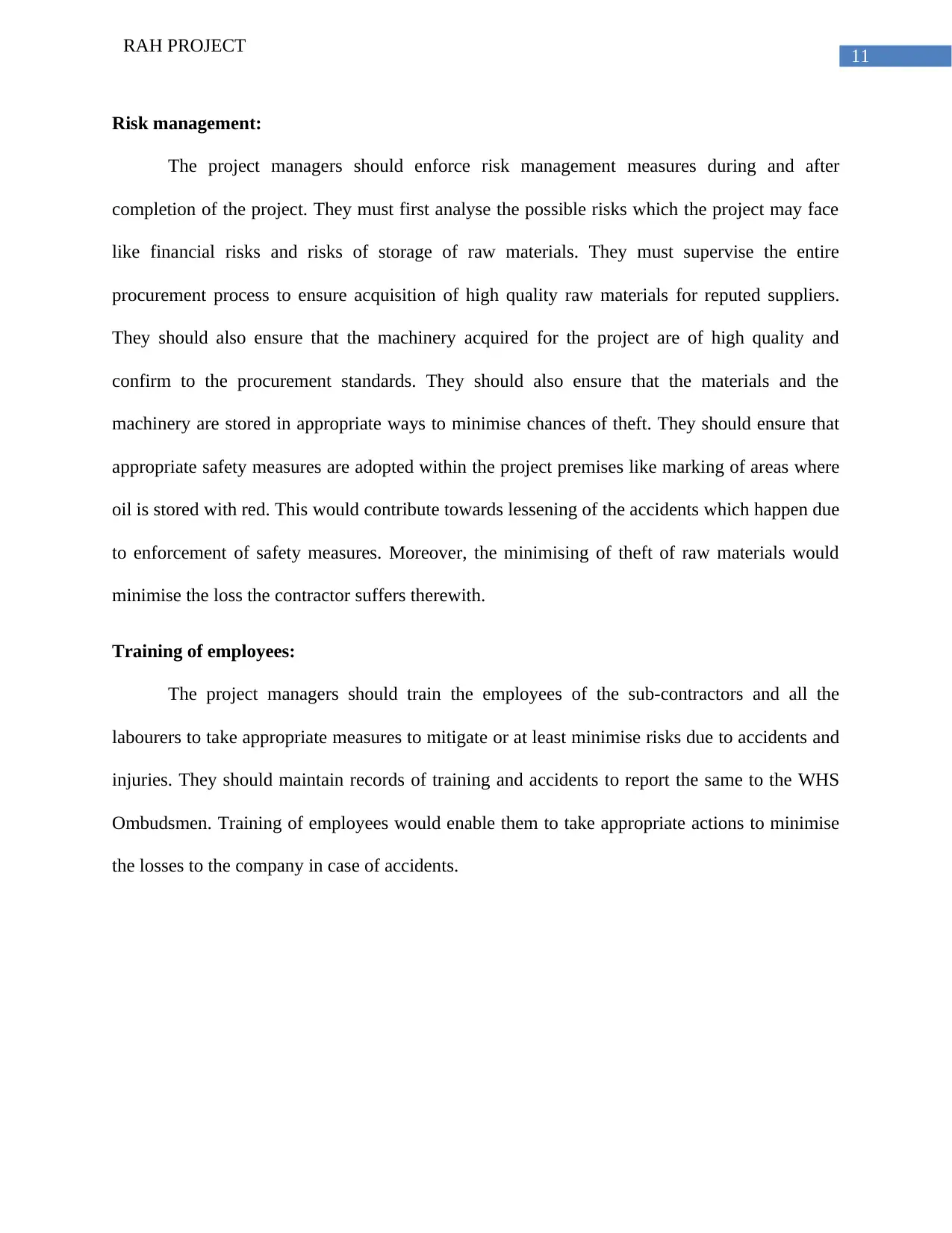
11
RAH PROJECT
Risk management:
The project managers should enforce risk management measures during and after
completion of the project. They must first analyse the possible risks which the project may face
like financial risks and risks of storage of raw materials. They must supervise the entire
procurement process to ensure acquisition of high quality raw materials for reputed suppliers.
They should also ensure that the machinery acquired for the project are of high quality and
confirm to the procurement standards. They should also ensure that the materials and the
machinery are stored in appropriate ways to minimise chances of theft. They should ensure that
appropriate safety measures are adopted within the project premises like marking of areas where
oil is stored with red. This would contribute towards lessening of the accidents which happen due
to enforcement of safety measures. Moreover, the minimising of theft of raw materials would
minimise the loss the contractor suffers therewith.
Training of employees:
The project managers should train the employees of the sub-contractors and all the
labourers to take appropriate measures to mitigate or at least minimise risks due to accidents and
injuries. They should maintain records of training and accidents to report the same to the WHS
Ombudsmen. Training of employees would enable them to take appropriate actions to minimise
the losses to the company in case of accidents.
RAH PROJECT
Risk management:
The project managers should enforce risk management measures during and after
completion of the project. They must first analyse the possible risks which the project may face
like financial risks and risks of storage of raw materials. They must supervise the entire
procurement process to ensure acquisition of high quality raw materials for reputed suppliers.
They should also ensure that the machinery acquired for the project are of high quality and
confirm to the procurement standards. They should also ensure that the materials and the
machinery are stored in appropriate ways to minimise chances of theft. They should ensure that
appropriate safety measures are adopted within the project premises like marking of areas where
oil is stored with red. This would contribute towards lessening of the accidents which happen due
to enforcement of safety measures. Moreover, the minimising of theft of raw materials would
minimise the loss the contractor suffers therewith.
Training of employees:
The project managers should train the employees of the sub-contractors and all the
labourers to take appropriate measures to mitigate or at least minimise risks due to accidents and
injuries. They should maintain records of training and accidents to report the same to the WHS
Ombudsmen. Training of employees would enable them to take appropriate actions to minimise
the losses to the company in case of accidents.
⊘ This is a preview!⊘
Do you want full access?
Subscribe today to unlock all pages.

Trusted by 1+ million students worldwide
1 out of 16
Related Documents
Your All-in-One AI-Powered Toolkit for Academic Success.
+13062052269
info@desklib.com
Available 24*7 on WhatsApp / Email
![[object Object]](/_next/static/media/star-bottom.7253800d.svg)
Unlock your academic potential
Copyright © 2020–2025 A2Z Services. All Rights Reserved. Developed and managed by ZUCOL.





